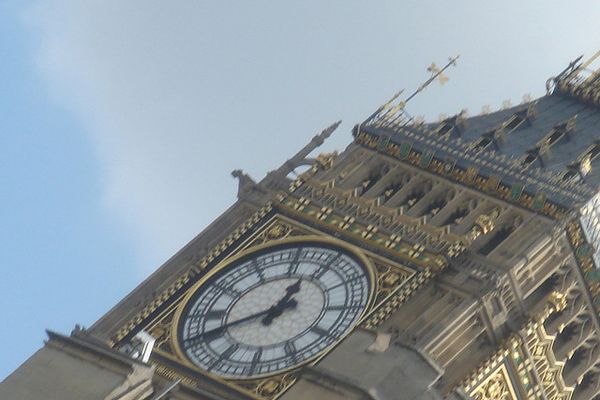Is London's Big Ben Falling Down?

In December 2011 British newspaper headlines warned that London's Big Ben was about to topple over. Locals instinctively blamed the London Underground's Jubilee Line Extension, which opened in 1999 and sends trains rumbling under the tower and the Palace of Westminster. What most did not know, however, was that rumors of the tower's doom, like Mark Twain's death, were greatly exaggerated; a reporter misread the final report on the extension's construction and its impact on the tower, which was filed in 2009 and released last year under the U.K.'s Freedom of Information Act. In fact, the builders took careful steps to ensure Big Ben's stability.
No building is ever completely still: they expand, contract and sway in response to the sun and wind, and they tilt and move when the ground underneath them shifts.
"It's like a sunflower. It bends with the weather and the time of year," says John Burland, an emeritus professor at Imperial College London.
Burland has a long, intimate history with the clock tower. He was called in to ensure its stability both when the Westminster station was reconstructed and extended downward to a depth of nearly 40 meters as part of the Jubilee Line Extension project and during the construction of a nearby underground parking lot in the 1970s. Burland also served in the early 1990s on a commission to stabilize the Leaning Tower of Pisa and, he says, now spends a lot of time on other projects that require building underneath sensitive, priceless buildings in built-up areas. The world's major cities have nowhere to expand but downward.
The technology to manage building movements has become very precise. A key component is accurate monitoring. Inside Big Ben's tower, a permanent automated plumb line-simply, a weight suspended on a string that serves as a vertical reference with which to compare the tower's angle of tilt-provides real-time measurements of its movement. A second surveying instrument, an optical plumb, now makes it possible to look up a vertical line from the tower's base to a target behind the clock.
"We're detecting movements to an accuracy of 10 millimeters daily."
During the extension work, the goal was to keep the tower from tilting more than an additional 27.5 millimeters over the length of the 55-meter span between the ground and the center of the clock face. Burland, however, prefers to talk in angles and gradients: 27.5 millimeters over 55 meters is a gradient of one in 2,000.
Sign up for the Live Science daily newsletter now
Get the world’s most fascinating discoveries delivered straight to your inbox.
To meet that goal, construction crews injected what is called "compensation grouting"-a mix of cement, sand, water and other components-into horizontal tubes drilled into the clay under the clock tower's foundation. The idea sounds simple: just push up on part of the foundation to counteract the building's lean. The secret, though, is being able to predict the direction and amount of building movement and knowing exactly where to place the channels and inject the grout.
The 61-meter-tall clock tower (technically, only the biggest bell inside it is "Big Ben") is built of brick, clad in stone and stands on a concrete raft 15 meters square, three meters thick, at a depth of seven meters below ground level. It is physically attached to the rest of the Palace of Westminster by a three-story building that houses the Parliamentary press and the offices of state.
The project installed the horizontal array of 16 steel tubes, each 50 meters long, by drilling outward from a vertical shaft immediately to the north, on Bridge Street. Whenever the tower's movement reached 22 millimeters, workers injected, in stages, 122 cubic meters of grout.
The exact ingredients of this mix are a proprietary secret known only to the contractor who supplied it. Even Burland isn't entirely sure of the recipe, although he says it includes some bentonite, used in the oil industry as a component of drilling mud, and that the mix is nontoxic and viscous enough to stop the ground from squeezing it.
Tourists today might note a definite tilt in the clock tower if they look closely but Burland says it is not caused by the London Underground; it has always been there.
"It's been known for more than a hundred years. It's probably been leaning since it was built in 1858."
Burland bases his argument on the condition of the stone cladding: "If the tower had started to lean to the left after the cladding was applied, the cladding would have been very badly damaged. There is no damage there, which leads us to believe it must have leant pretty early on, while they were still putting the cladding on." He estimates the tower's lean at a gradient of about one in 250.
"It's just about visible. Much more than that and people get a little bit uncomfortable. But it takes quite a lot more to need remediation-one in 100." The Pisa tower, he says, had a lean of one in ten. "It's terrifying if you walk on the side of Pisa, especially when clouds are moving."
At the time, compensation grouting used to prevent further leaning was a relatively new technique. Today new, automated methods of tunneling create much less ground movement.
"If we were building [the extension] now, we would have done it differently," Burland says. The high-speed rail link to the Channel Tunnel, which opened in 2003, "was constructed under very sensitive buildings and used one of the much more modern tunneling machines, and the movements were much smaller. There was a lot learned on the Jubilee Line Extension."
This article was first published on Scientific American. © 2011 ScientificAmerican.com. All rights reserved. Follow Scientific American on Twitter @SciAm and @SciamBlogs. Visit ScientificAmerican.com for the latest in science, health and technology news.











